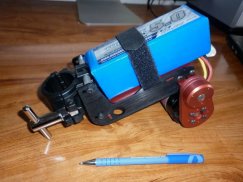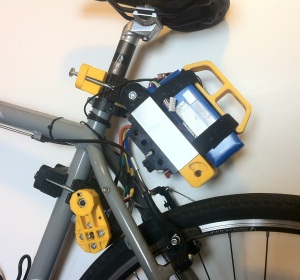This is part 1 of a series. You can find part 2 here, and part 3 here.
I love riding my bicycle and I think its a shame that the suburb of Dayton I live in is designed for car use only. That means no bike lanes, high speed limits, busy intersections, and a low density packing of places I’d want to ride to.
As a result I’m the only one I ever see pedaling across the nearby 6 lane intersection to the store. Or shopping while dripping with sweat and a backpack full of groceries for that matter.
I figured an electric bicycle could make my life a lot easier. Plus they’re freaking cool.
Unlike my electric motorcycle project, e-bikes are a very environmentally friendly and practical mode of transportation. Bicycles are the most energy efficient human powered vehicles and electric vehicles are the most efficient form of powered locomotion. Combine the two and magic happens.
But I’m not interested in dropping $4,000 on a brand new e-bike, or even $1,300 on a standard hub motor conversion kit.
All I need is an occasional boost, so over the past couple months I’ve created a low cost high value EV conversion kit: The ‘Bicycle BoosterPack’.
The BoosterPack (so named because it makes me think of a jetpack) is designed to quickly mount to the seat post of adult size road commuting bicycles to give them an electric boost at the push of a button.
It uses friction to drive the rear wheel, but it only touches the tire when the button is pushed. The drive motor is on a swing arm with a spring pulling it away from the tire. When the button is pushed the rapid spinning of the motor swings it into the tire. In this way it doesn’t add drag or rotating mass when not in use!
Another big feature of this design is that it can be completely removed in seconds. Unlike traditional E-bikes where the entire vehicle is expensive and at risk of being stolen off the bike rack, the Bicycle BoosterPack can be taken with me wherever I go.
What’s more awesome is that I don’t need a special license or registration to drive this thing. E-bike laws vary throughout the US, but this hybrid technology is considered legal as long as I abide regular bike laws. The bike is still a regular bike when it’s not boosting!
.
Performance Specs:
The blue brick is the battery pack and while it has an extraordinarily high energy density, expectations for this thing need to be kept grounded in reality.
As it is the entire assembly only weighs 4 lbs and the bike gets a 5 mile range of pure boost with a top speed around 25 mph. A second or third battery can be added easily if more range is desired. For me, 5 miles drawn out over intermittent 10 second boosts is more than enough to get around.
.
History:
Friction drives have been around for a while of course, and I was not the first to think of building one using RC components and a swinging motor mount.
The ultimate credit for the concept goes to a couple engineers from Australia named Kepler and Adrian, who created fully functional products a few years ago. The ‘Eboost’ and the ‘Commuter Booster’, pictured below.
So why can’t I buy a ‘Commuter Booster’ or an ‘Eboost’?
Unfortunately, they were never able to successfully commercialize their designs, despite a huge demand for their products.
Their primary challenges turned out to be manufacturing costs, managing consumer support (they used a custom interface and throttle), and restrictive Australian (& European) bicycle laws.
On the other hand, my 3D printed design and supplier relationships have enabled me to produce a more universal and easier to use device at a reasonable cost. And I live in the glorious United States of Freedom.
Also I have the time to experiment until it’s perfect
Challenges:
My little projects need to start pulling their financial weight around the house and selling BoosterPack kits is an exciting new kind of experiment for me. But I have my own unique set of challenges to face first.
- Anyone familiar with EVs already knows this but batteries are the biggest limitation. The energy dense Li-Po batteries I used are quite safe when handled appropriately, but I wouldn’t say that they are kid proof. I do have the capability to package some ultra-safe long life LiFePO4 batteries, but at a much greater cost than the Li-Po batteries.
I plan to sell the kit minus the battery and provide a link to a 3rd party supplier and instructions for battery care & installation.
- Friction drives don’t like water. While the entire device is electrically contained and water resistant, it simply won’t drive a wet tire. My experiments with a sandpaper drive roller greatly improved wet traction but at the cost of noticeably increased tire wear. I think this can be resolved but more research is needed.
- I wanted this device to be as universal as possible. But bicycles are as varied as dogs, perhaps more so, and the number of standardized parts and dimensions is fewer than you might think. There can never be a one size fits all solution.
That said, my clamp design can hold onto round seat posts of the most common sizes (from 21mm to 39mm), and the frame is adjustable enough to function on most adult size road commuter bikes. (No knobby mountain bike tires though).
I’m working on a second configuration that can mount lower on the frame. The tricky part is preserving the portability/removability aspect that I value so much.
- The biggest challenges are non-engineering related. People want these things and I want to sell it to them, but providing adequate installation support to something that is inherently not simple and protecting myself from litigation are real hurdles to deal with.
When I figure all that out I’ll post the first batch on Ebay and make an Instructables to share the assembly directions, how to use it, and design theory. If you want to be one of the first people to own one then you can send me an email at MechEngineerMike AT gmail.com or you can keep watching this blog for a notification!
If you want to help out then you’re more than welcome to leave some feedback in this brief survey. Thanks! http://goo.gl/forms/eJ7aIb8OMi
EDIT 4-10-16: The instructables is out now, check it out here!







Excellent work, great job. Looking forward to see how you improve it.
LikeLiked by 1 person
Thanks!
LikeLike
is this illegal to ride in California
LikeLiked by 1 person
Nope, in California it is a ‘class 2 electric bicycle’ and so does not require a special liscence or plates! Drinking & driving laws DO apply though, and laws might be more/less strict is specific cities.
In any case, the bike is a regular bike when it’s not boosting!
More info: https://en.wikipedia.org/wiki/Electric_bicycle_laws#California
LikeLike
Hey Micheal, very nice project. About how much current can this device draw? I’m thinking about this type of conversion but using old 18650 cells from laptops for the battery pack.
LikeLike
Thanks! My calculated max current is 36 amps. I just did an experiment and I got it up to 30 amps before major slipping of the motor relative to the tire occurred, limiting the current. And that’s actually a good thing. The device is not current controlled so if the motor were to be held in a vice the current would go up to the 100A that my battery can supply and quickly fry the motor. (30A is still a lot though, note the radial fan on my motor, which has helped immensely!)
You could probably get away with 18650 cells in a 2p configuration. The batteries I’m looking at for future ‘safe packs’ are 26650. One thing about those cells is that LiFe voltages are lower than LiPo, so if you are using an RC ESC then it can get confused and overdischarge your pack. To solve this I’ve found that the safe working voltages for a 6s LiPo pack align with those of a 7s LiFe pack.
LikeLike
Nice job 🙂
I’ve two suggestions which might be very noob-ish, but bear with me :p
Why don’t you try recharging the batteries as you cycle? Converting the mechanical motion of the wheel into electrical energy and storing it in the battery itself.
Or is there any mechanical way to store some of the rotational energy? Is there any way you could coil a spring or something, make a button to uncoil that for special booster power? Idk why but isn’t just cycling a waste of that rotational motion?
LikeLiked by 1 person
Thanks! My research has shown that regenerative brakes on vehicles this size can only recover enough energy to extend the range by about 7% (so .35 miles of boost here). So I’ve chosen to prioritize simplicity with this design and selected less expensive electronic components that aren’t capable of regen.
I know 5 miles of ‘pure’ boost doesn’t sound like much but the practical range is quite a bit more than that. A new EV product in Europe called the ‘Add-e’ uses VERY similar components to mine and yet they advertise the practical range to be nearly 30 miles because it is intended to be a ‘pedal assist’.
LikeLiked by 1 person
Oh haha that’s marketing right there.
It’s really nice to know that there are engineers out there who actually make stuff and solve small day to day problems. Cheers!
LikeLiked by 1 person
[…] PS: If you’re just tuning in, you might want to catch up with Bicycle BoosterPack Part 1. […]
LikeLike
Do you have the links where i can get the motor and esc
LikeLiked by 1 person
Hi Adam, My recommended supplier Is Maytech Motors which has to be contacted by email. I list a complete BOM in STEP 2 of this instructable here: http://www.instructables.com/id/Bicycle-BoosterPack-a-3D-Printed-Portable-Electric/
LikeLike
Luar biasa modelnya….. Mudah-mudahan harganya bisa murah untuk masuk ke Indonesia, agar negara kami bisa bebas polusi
LikeLike
hi mike…I built one of these and it worked…well, very nearly…didn’t seem to generate enough power to spin my bike wheel however i later found out my wheel was quite badly untrue so i suspect that was the real issue. Finally got wheel corrected so i dug the booster out of my shed and went to test it. Had been in storage for quite q while – maybe as much as a year but battery seems fine (All: 24.5 and each 4.06-4.08). Checked programming of speed controller and all previous programmed settings remained and match your specified setting. So held down the set button and switched on and blue light comes on but no beep. max’d the throttle, unplugged ecs lead several times but no beep. played with everything again and again but no beep so am completely lost. any suggestions please?
LikeLike